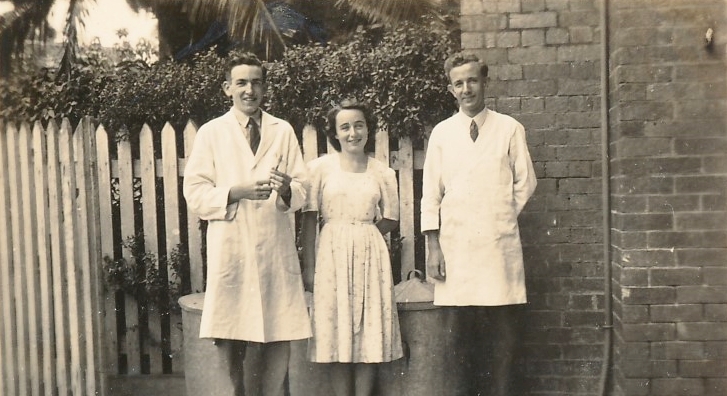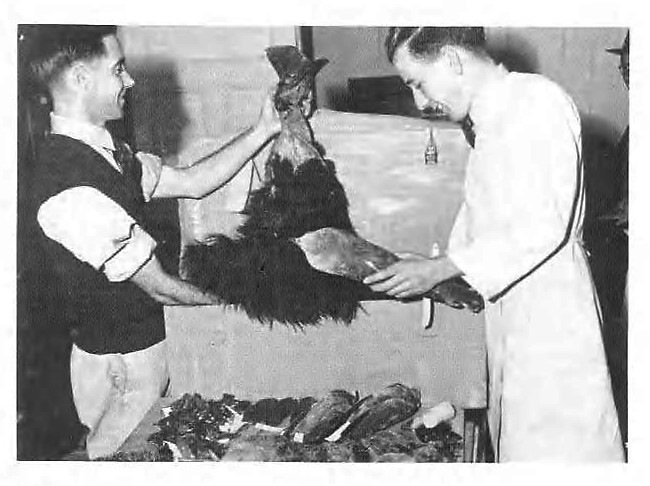In 2001, the QYO Big Band had just finished its second tour to regional North Queensland. As part of the partnership between Comalco and Bundaberg Sugar, the band was formed to entertain audiences in Weipa, Mapoon, Arakun, Babinda, Mareeba and Atherton. The band formed incredible bonds and musical friendships that are still cherished to this day. Although the band was not considered an official part of QYO and could not yet afford a conductor to run the band, the students were adamant that the band would continue to rehearse and serve QYO where and when it could. The band organised (without social media) a time to rehearse and without fail, the students all agreed on a time but the venue was still to be decided. Being a Big Band, rehearsal at home was not an option with limited space, and, as we were all students, we could not draw upon the our alma mater. Thankfully, The Old Museum was available and QYO was generous enough to schedule a rehearsal each week in Studio 2. The band begged and borrowed music to rehearse and thoroughly enjoyed each other’s musical company. Two years later, in 2003, QYO was given permission to play as part of the all groups ‘Finale’ concert at QPAC cementing their place as part of the QYO ensembles. If it were not for the dedication of those students and the availability and generosity of QYO to provide the Big Band with The Old Museum as a rehearsal venue, we would not have had a platform for some of Australia’s finest young musicians to grow and develop in the Big Band idiom. Since formally existing as part of the QYO organisation, the Big Band has performed with James Morrison, Tom Burlinson, Andy Firth and Naomi Price. Amongst the students that have benefited from the Big Band program are Adelina Martinez (James Morrison Scholarship winner and current singer with James Morrison as a direct result of a performance with James Morrison), Dave Khafagi (Principle Trumpet ASO), Ben Beavis (Band of the Grenadier Guards), Lt David Coit (Officer in Charge of the Australian Navy Band Melbourne) and countless other performers and educators around Australia and the world. Thank you, The Old Museum.
This is a reflection of my father’s time at the Queensland Museum.
In late 1944, at just 16 years of age, Ivor Filmer walked down Gregory Terrace from Brisbane Grammar School one day, to the Queensland Museum. There, he asked the director if there was any chance of employment. Ivor was informed that most of the staff were at the war, and he would be ‘very useful’.

1946, taken during the RNA show
Not long after Ivor commenced the director, Heber Longman, became ill, and was on sick leave for long periods. So it was that Ivor became the junior assistant, at aged 16. At a time when a search on the internet for information was many decades away, Ivor was delegated to handle the enquiries on natural history from the public, and by post. He recalls that the information had to be found, and there was no one else to do it, so in effect he couldn’t help learning many things. His instruction was to elicit ‘two pertinent facts’ and the information would be given via phone to the director for confirmation, by Miss Murphy in the office. The large library, full of weighty tomes and priceless literary works, was Ivor’s domain. A ladder was available for access to high shelves.

Receiving a specimen (undated). Ivor on right.
As a young assistant in the museum at this time, Ivor did almost every job there was to be done. He cleaned and fumigated display cases and spirit tanks, ran messages, arranged displays, labelled specimens, filled up jars, made catalogues, registered acquisitions and identified specimens— sometimes with Mr Longman’s help, but often he had to do it on his own. When Longman was away, he answered most of the public enquiries. When Miss Murphy was away, he was clerk as well.
Ivor was enthusiastic about the museum and natural history. Daily, he kept a diary to record the tasks he completed and the conversations he had with Longman, who encouraged the young naturalist, discussing distribution, nomenclature, biology.
At Longman’s retirement there was excitement and consternation, when at short notice, on 11 June 1945, the Duke of Gloucester decided to visit the museum, and on that very day the director was away sick. The duke arrived, dressed in military uniform with the duchess by his side. They were accompanied by the governor of Queensland, Sir Leslie Wilson, and his aide. The welcoming party, comprising J. Edgar Young (honorary paleontologist), Michael Beinie (head attendant), and Ivor, guided the royal couple and the governor around the galleries. The duke then signed an historic bible, donated by J Wilkinson, the first member for Moreton in the federal parliament. According to Ivor, it was a dull overcast day, and matches had to be lit occasionally to show the duke a specimen or to light up a label. Looking back one wonders just what the duke thought about a state museum where matches had to be used for illumination of specimens and labels. The museum galleries were lit with electricity for the first time in their history only in August 1948.
On 14 August 1945, World War II ended. Ivor recorded the receipt of that news:
“A unique day in our history, and in my life. Peace was officially announced at 9.30 this morning, and at the museum we received the news with joy. The attendants rang the bell, shouting “Hooray!” through the galleries and Mr Longman and I found an old Balinese gong which we banged and made a loud ringing noise outside the back door, but there was no one there to hear us”.
Ivor particularly enjoyed the field trips. Many times he made expeditions with other staff, usually to collect perches for bird displays. They would catch the train from Brunswick Street to Mitchelton and then walk to Samford Road or to Ferny Grove, sawing off the logs they needed and carrying them back to the station in sacks.

1948, Ivor on right
Ivor also started assisting with taxidermy. “24 March 1947: an important day in my career— tackled my first skin”. He assisted in the maintenance of displays, and many other tasks, from 1944 to 1952. His keen interest in natural history persisted after he left the museum and he continued to send in road-killed and storm-washed specimens. While in charge of the Australian Inland Mission Hospital at Birdsville from 1957 to 1959, he collected more than 200 vertebrates, including rare mammal and bird specimens, some of which were mounted for display. He usually air-freighted the specimens from Birdsville to Brisbane and on one occasion he sent a live python, with two rats in the container to serve as food. However, when museum staff opened the box they found that instead of the python having eaten the rats, the latter had nibbled the python. In all, Ivor spent 8 years or so at the Queensland Museum.
Some of these notes are also located in the book A time for a museum: history of the Queensland Museum: 1862-1986. The authors utilised various notes from Ivor’s diaries that he kept at the time.
I grew up in Windsor in the 1960s. When I was about 9 or 10, it was not unusual for our mums to give us 2/- (20c) and tell us to go out for the day. There was nothing my friends and I liked more on a weekend than to catch the tram to the Centenary Pool, then follow it up with a visit to the Old Museum. There were usually 5 or 6 of us (no adults) and we would spend hours exploring the nooks and crannies of the old Gothic building in Gregory Terrace or playing on the Mephisto Tank that stood like a guardian at the main entrance. One day we decided to play a game of hide and seek on the first floor where all the insect cabinets were. I always found this the most interesting part of the Museum, because you could look down on the T Rex skeleton or Bert Hinkler’s Avian from above. Anyway, we were playing hide and seek when my friend said he spotted one of the girls in our group hiding on the stairs leading up to the next floor. However, when we called out to her, she took off up the stairs. To our surprise, when we turned around our friend was behind us and she said that she had spotted the other girl too. So we went to see where the girl on the stairs had gone, but when we got there we found that the stair led to a door that was firmly locked. I had not thought about that much in the past 50 years until recently when I was talking to Alannah Ruth, the present curator of the Old Museum Building, who told me an eerily familiar story about the Ghost of the young girl who lives on the stair!
I started work in the Old Museum in the entomology section in February 1982 and so had four years there until we moved in 1986.
I had visited as a young kid and always wanted the keys to the insect display cases. So I achieved one of my childhood ambitions. Many of these insect displays had been done by Henry Hacker in the early twentieth century and had not changed. There were some modern panels in the old cases but not many. The old displays had canvas covers to exclude the light, which you lifted to look at them. These were later removed. The cases were beautiful cedar, with turned legs and angled panes of old glass on each viewing side. The displays were on angled, paper-covered pine boards with old, specially printed labels on grey card (done by the Government Printer) and the insect specimens were pinned directly into the hoop pine through the white paper. There were many interesting life histories and rare specimens but time had faded them. When the move came we kept the specimens but could not store the whole displays.
Some fish were displayed in similar cedar cases. The fish were hand-painted plaster casts. I remember being on the display floor with other staff, when a nearby young girl suddenly burst into giggles. The education officer calmly said “Ah! She’s found it”. There was a biro nib sticking out of the mouth of a parrot fish.
By that time the Queensland Art Gallery had moved out and QM staff had filled every nook and cranny of the buildings and out buildings. Admin was in a demountable, as was conservation, while history and technology was in some of the big sheds.
Art and display staff were mainly in the old concert hall where the art gallery had been. Melba had sung there in the past and it was where the city hall organ was originally installed. We could go up the grand stairway to where archaeology and ethnology collections and staff were housed. Sometimes I even went up into the towers. Now all this is deemed unsafe and off limits.
Curatorial staff were mainly in the basement, entered round the back. There was one toilet for each gender, way into the bowels of the building near the earth basement.
The wonderful library had spilled out of its main room down the long, high-ceilinged corridors and I passed old books like The Pears of New York and early hand-coloured insect publications on my way to my desk.
There was no air conditioning and the west wall heated up like an oven in summer. The concrete floors were cold in winter too. The entomology room at the end of that long book-lined corridor had staff crammed in among the lovely old cabinets with a strong smell of naphthalene. There was a big white, arched, drop-sash window at the end of the room away from me and my boss.
In spring the gardens were a delight, with wonderful hedges of jasmine, beds of Iceland poppies, pansies, stocks and roses. We used to take our morning tea out to enjoy there on nice days. During the Ekka the noise of people on the rides was a constant background. We felt privileged with free parking in the middle of it all.
The switch board was a plug-in manual type and there were constant PA announcements when the receptionist couldn’t find someone at their desk. There was a big typing pool of women typists, as there were no computers and curators spent a lot of time writing letters, long hand, which were then typed, checked, signed and the pink carbon copy filed.
The staff was relatively small and I often ate lunch with the then director and other senior staff but that was always inside, at a big old pine table. As a whole, the staff were an amazing bunch of talented, friendly people, with the most incredible range of knowledge and skills (as is still the case). There were conflicts but generally it was a happy place and the amount of work done was prodigious. Filling the whole new museum with displays was a massive job. I remember volunteering to help with whale construction one weekend. I think I helped glue on cast barnacles.
One Friday afternoon, 18 January 1985, there was a huge hail storm. It was after 4.00 pm and many staff had gone home. I remember grabbing old books off bookshelves in the late Patricia Mather’s office, as water started to pour down the walls. I don’t recall any damage to the precious books but it was a near-run thing. Other staff were trapped higher up in the building, as about 360 panes of glass were smashed by the hail and shards of glass flew everywhere. Some shards like daggers were later found embedded vertically in the old pine stairs. When I went to my car the back windscreen was smashed, there was extensive panel damage and a foot of water and ice round the pedals.
A special highlight was the day the machinery restoration team fired up the Garrett traction engine for the first time. The brightly painted engine, sounding its whistle and trundling round the bitumen drives was unforgettable, as was the pleased-as-punch face of the chief restorer.
One time, to the surprise of all, a noisy pitta turned up in the museum garden and took up residence for quite a while.
The move to the Cultural Centre was a huge job. My fellow insect technician, the late Gudrun Sarnes, and I moved 1,000 drawers of insects in the back of a Toyota Hi-Ace van, driving very slowly on many trips. Not a specimen was damaged.
I went on my first trip to Europe in 1986 but returned just in time for the final staff party at the old building. It was a lovely gathering with past and present staff all enjoying the side verandah. I still miss things about the old place.
I would have been 10 or 11 when I came the first time. I came a couple of times on school excursions with the Ascot State School. I was born in ’52, so was at school in the late ’50s and ’60s. We would have come in by bus—the bus route went along Anthony Street. At the bottom you could get a tram from Oriel Park.
I remember the size and grandeur of the building, and the large rooms, and the quiet. When we came it was really hot, and inside was really hot, even though the ceilings were high. I remember the display cases, and not to lean on them! It was the only place you could see a dinosaur.
I used to swim at Centenary Pool and the Spring Hill Baths, and see the beautiful old building. I would see it with its windows broken—that made me sad. I think buildings need to be loved and lived in and filled with people.
I called in today as I’m here with my husband, who’s the dairy rep on the RNA council.
A note from the editor: Mary Jensen told this story to Margie Barram at the Australian Garden History Society display at the Ekka.
My daughter Pam, who’s now 54 and lives in Melbourne, came here often with her father, and sometimes we’d all come together. I recall the big display cabinet with the African lion—Pam must have only been five or so, because the lion was bigger than her. It had presence, even though it was a bit moth eaten.
There were these rows of display cabinets, and signs “Don’t lean on the glass”. It is altogether different now—all hands on. But then it was stand back and observe. We’d talk about what we were seeing, and learn about the exhibits. Now it seems the parents are all on their phones while the children play—not something done together.
A note from the editor: Myra Collom told this story to Margie Barram at the Australian Garden History Society display at the Ekka.
I came on a school excursion from Ipswich—into the big smoke. This would have been in the early 1970s.
It was a jaw-dropping experience—the internal size of the building; the BIG dinosaur inside!
A note from the editor: John Russell told this story to Margie Barram at the Australian Garden History Society display at the Ekka.
I’m from a Brisbane family and we visited throughout the 1970s. The glass cases stand out in my memory, and also the garden. I’m here with the Ekka—it’s great the gardens survived and weren’t hacked about with all the different uses since the museum left.
A note from the editor: Elizabeth Gillespie told this story to Margie Barram at the Australian Garden History Society display at the Ekka.
I was brought up in Africa and my family moved to Brisbane in 1965. My parents took us to the museum in the first year we were here—so I would have been a 15 year old.
What I remember is the tiger—I had always pictured it as the size of a leopard, an animal I knew from Africa. But it was much bigger.
A note from the editor: Andrew Jackson told this story to Margie Barram at the Australian Garden History Society display at the Ekka.


Recent Comments